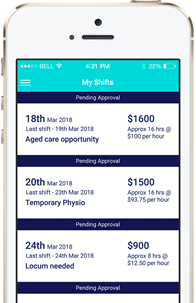We’ve created 3 main categories of locums that we think you may fall into. We’ve also added a bit of info on how you’d set this up in Lokko.
- The extra cash locum (Wanting to do an occasional after hours shift in addition to your 9-5 job) – Most likely you would want to see shifts that are local only to you in this instance so the first step would be to add the location of where you reside and adjust the radius to reflect the distance you are willing to travel. Presumably, you want to earn a certain hourly rate so you might set your minimum rate to $55 to only see shifts with this rate or higher. Lastly, you’ll need to set the time parameters for when you are available to only see shifts that fall in this time. EG. Saturday 9-1pm, Thursday 6pm – 9pm. This way you will only see shifts in your area, over or equal to $55 per hour and Saturday morning or Thursday evening.
- The Lifestyle locum (wanting to travel and work and have a diverse range of work in your field) – You want to see shifts all around Australia/your country and are happy to travel wherever needed. You probably still have a minimum hourly rate you want to achieve so you can adjust that in the notification filter. Set the location as your country and increase the radius to the maximum. Leave the hours available as available anytime or within Monday -Friday if you prefer or detail your preference.
- The local Lokko’er (using the app full time or part time in your city) – You want the flexibility that comes with being a full or part time locum so you use the app when you want to work and keep yourself unavailable when you don’t. Set the location to your local area and set the radius to how far from that area you are willing to work. Set the hourly rate to what you are willing to work for and adjust your available times to reflect when you want to work. Want a day off to run errands, hang with your kids, go surfing, take the dog to the park, hang at the coffee shop all day working on your side project, play golf or work at a charity this is for you!
lokko.work










